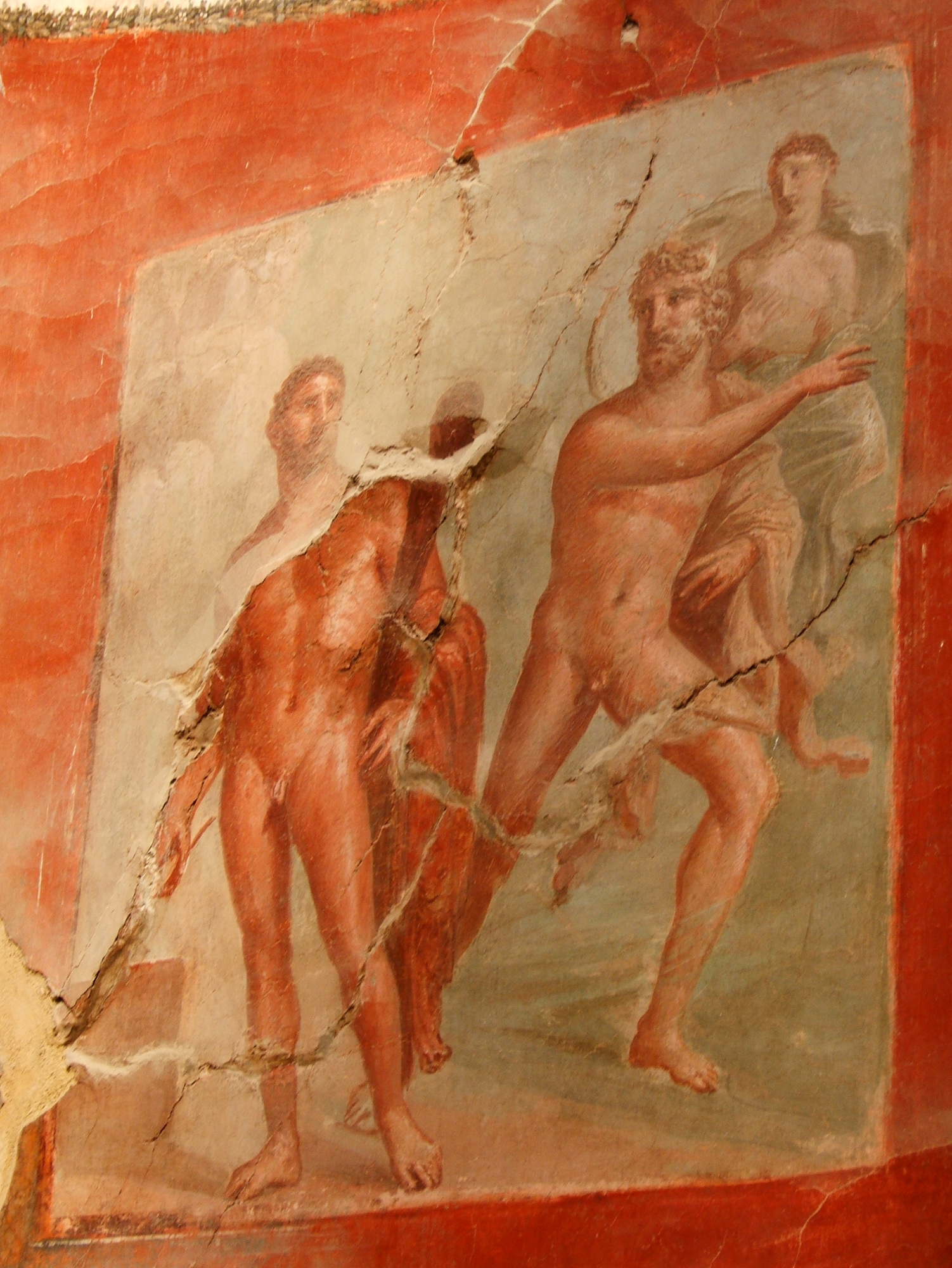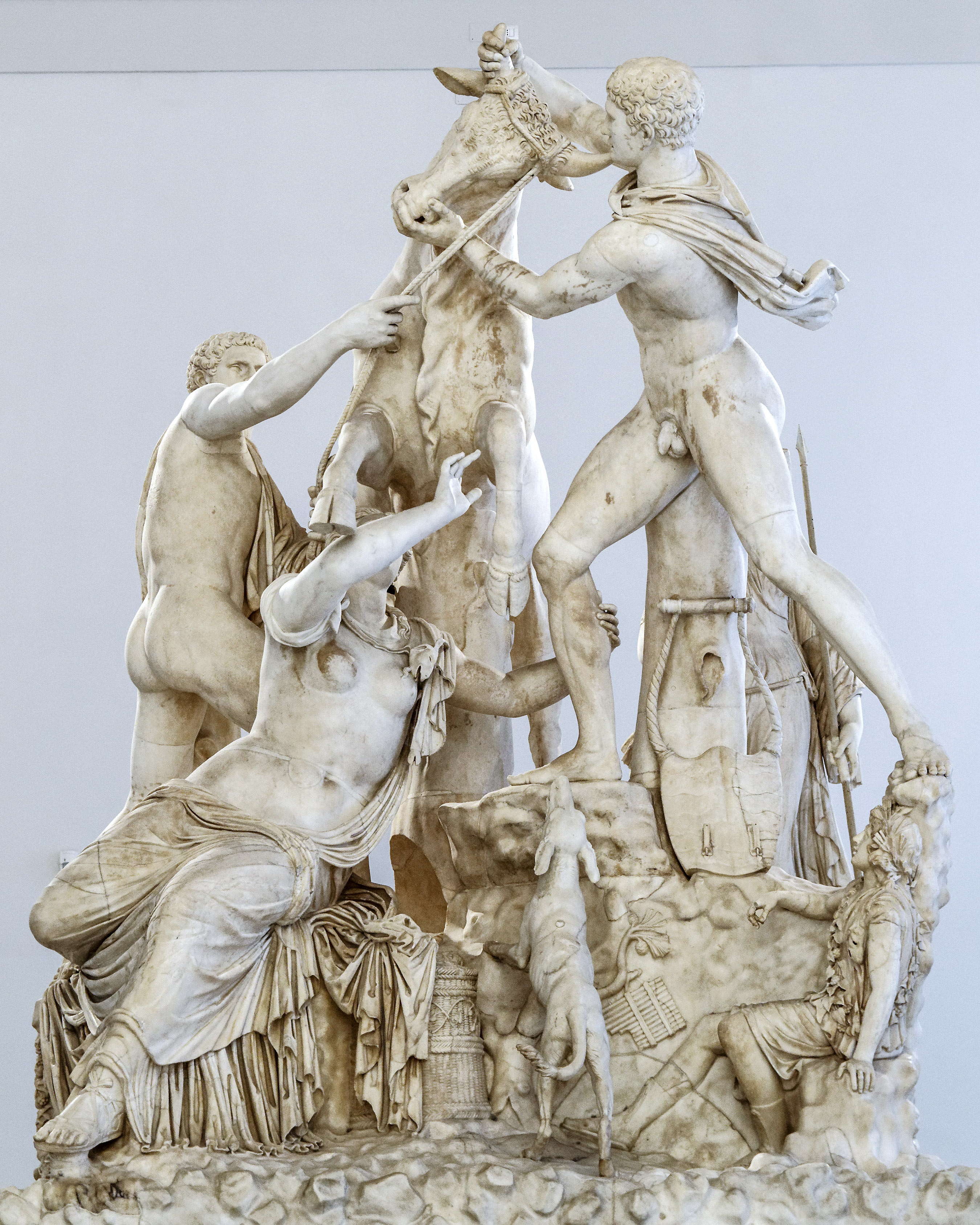|
Dirce
Dirce (; , , modern Greek , meaning "double" or "cleft") was a queen of Thebes as the wife of Lycus in Greek mythology. Family Dirce was a daughter of the river-gods Achelous or Ismenus, or of Helios. Mythology After Zeus impregnated Dirce's niece Antiope, the latter fled in shame to King Epopeus of Sicyon, but was brought back by Lycus through force, giving birth to the twins Amphion and Zethus on the way. Lycus gave Antiope to Dirce. Dirce hated Antiope and treated her cruelly, until Antiope, in time, escaped. In Euripides's lost play ''Antiope'', Antiope flees back to the cave where she gave birth to Amphion and Zethus; they are now living there as young men. They disbelieve her claim to be their mother and refuse her pleas for sanctuary, but when Dirce comes to find Antiope and orders her to be killed, the twins are convinced by the shepherd who raised them that Antiope is their mother. They kill Dirce by tying her to the horns of a bull. Dirce was devoted to t ... [...More Info...] [...Related Items...] OR: [Wikipedia] [Google] [Baidu] |
Antiope Of Thebes
In Greek mythology, Antiope (; Ancient Greek: Ἀντιόπη derived from ''αντι ''anti "against, compared to, like" and ''οψ ''ops "voice" or means "confronting") was the daughter of the Boeotian river god Asopos (Boeotia), Asopus, according to Homer; in later sources she is called the daughter of the "nocturnal" king Nycteus of Thebes, Greece, Thebes or, in the ''Cypria'', of Lycurgus of Thrace, Lycurgus, but for Homer her site is purely Boeotian. She was the mother of Amphion and Zethus. Myth Her beauty attracted Zeus, who, assuming the form of a satyr, rapes her. A.B. Cook noted that her myth "took on a Dionysiac colouring, Antiope being represented as a Maenad and Zeus as a Satyr". This is the sole mythic episode in which Zeus transforms into a satyr. Being pregnant with Zeus's child, Antiope feared the wrath of her father, Nycteus, and fled to Sicyon, where she married Epopeus (king of Sicyon), Epopeus.Roman, L., & Roman, M. (2010). After this she was carried off b ... [...More Info...] [...Related Items...] OR: [Wikipedia] [Google] [Baidu] |
Amphion And Zethus
Amphion ( ()) and Zethus (; Ζῆθος ''Zēthos'') were, in ancient Greek mythology, the twin sons of Zeus (or Theobus) by Antiope. They are important characters in one of the two founding myths of the city of Thebes, because they constructed the city's walls. Zethus or Amphion had a daughter who was called Neis (Νηίς), the Neitian gate at Thebes was believed to have derived its name from her. Mythology Childhood Amphion and Zethus were the sons of Antiope, who fled in shame to Sicyon after Zeus raped her, and married King Epopeus there. However, either Nycteus or Lycus attacked Sicyon in order to carry her back to Thebes and punish her. On the way back, she gave birth to the twins and was forced to expose them on Mount Cithaeron. Lycus gave her to his wife, Dirce, who treated her very cruelly for many years.Apollodorus, 3.5.5 Antiope eventually escaped and found her sons living near Mount Cithaeron. After they were convinced that she was their mother, they killed ... [...More Info...] [...Related Items...] OR: [Wikipedia] [Google] [Baidu] |
Lycus (brother Of Nycteus)
In Greek mythology, Lycus or Lykos ( ; ) was a ruler of the ancient city of Ancient Thebes (Boeotia). His rule was preceded by the regency of Nycteus and in turn, Lycus was succeeded by the twins Amphion and Zethus. Family Lycus and his brother Nycteus were the sons of either (1) Chthonius, one of the Spartoi;Apollodorus, 3.5.5 or (2) of the nymph Clonia and Hyrieus, the son of Poseidon and the Atlantid Alkyone; or lastly (3) of Poseidon and the Pleiad Celaeno. He was married to Dirce and possibly by her, the father of another Lycus. Lycus was the uncle of Antiope, daughter of Nycteus. Mythology Lycus and Nycteus fled from Euboea after they murdered King Phlegyas, settling in Hyria and then moving to Thebes, because they were friends with Pentheus, its king. Pentheus's successor was Polydorus, who married Nycteis, the daughter of Nycteus. Nycteus served as regent for Labdacus, the son of Polydorus, when Polydorus died at a young age. Nycteus's daughter, Antiope, was ... [...More Info...] [...Related Items...] OR: [Wikipedia] [Google] [Baidu] |
Helios
In ancient Greek religion and Greek mythology, mythology, Helios (; ; Homeric Greek: ) is the god who personification, personifies the Sun. His name is also Latinized as Helius, and he is often given the epithets Hyperion ("the one above") and Phaethon ("the shining"). Helios is often depicted in art with a radiant crown and driving a horse-drawn chariot through the sky. He was a guardian of oaths and also the god of sight. Though Helios was a relatively minor deity in Classical Greece, his worship grew more prominent in late antiquity thanks to his identification with several major solar divinities of the Roman period, particularly Apollo and Sol (Roman mythology), Sol. The Roman Emperor Julian (emperor), Julian made Helios the central divinity of his short-lived revival of Religion in ancient Rome, traditional Roman religious practices in the 4th century AD. Helios figures prominently in several works of Greek mythology, poetry, and literature, in which he is often described ... [...More Info...] [...Related Items...] OR: [Wikipedia] [Google] [Baidu] |
Achelous
In ancient Greek religion and Greek mythology, mythology, Achelous (also Acheloos or Acheloios) (; Ancient Greek: Ἀχελώϊος, and later , ''Akhelôios'') was the god associated with the Achelous River, the largest river in Greece. According to Hesiod, he was the son of the Titans Oceanus and Tethys (mythology), Tethys. He was also said to be the father of the Siren (mythology), Sirens, several nymphs, and other offspring. Achelous was able to change his shape, and in the form of a bull, he wrestled Heracles for the right to marry Deianeira, but lost. He was also involved in the legend of the Argos, Peloponnese, Argive hero Alcmaeon (mythology), Alcmaeon. Etymology The name Ἀχελώϊος is possibly pre-Greek, its meaning is not entirely certain. Recent arguments suggest it is Semitic languages, Semitic in origin, with the initial Αχ- stemming from the Akkadian (language), Akkadian ''aḫu'' ("bank of the river"), or ''aḫû'' ("seashore") and the suffix -ελώἴ� ... [...More Info...] [...Related Items...] OR: [Wikipedia] [Google] [Baidu] |
Farnese Bull
The ''Farnese Bull'' (), formerly in the Farnese collection in Rome, is a massive Roman elaborated copy of a Hellenistic sculpture. It is the largest single sculpture yet recovered from antiquity. Along with the rest of the Farnese antiquities, it has been since 1826 in the collection of the Museo Archeologico Nazionale Napoli in Naples, inv. no. 6002, though in recent years sometimes displayed at the Museo di Capodimonte across the city. The sculpture in Naples is much restored, and includes around the base a child, a dog, and other animals not apparently in the original composition, which is known from versions in other media. Pliny the Elder mentions what was presumably the prime version of it as the work of the Rhodian artists Apollonius of Tralles and his brother Tauriscus, stating that it was commissioned at the end of the 2nd century BC and carved from just one whole block of marble. It was imported from Rhodes as part of the remarkable collection of artwork and sculpt ... [...More Info...] [...Related Items...] OR: [Wikipedia] [Google] [Baidu] |
Thebes, Greece
Thebes ( ; , ''Thíva'' ; , ''Thêbai'' .) is a city in Boeotia, Central Greece (administrative region), Central Greece, and is one of the oldest continuously inhabited cities in the world. It is the largest city in Boeotia and a major center for the area along with Livadeia and Tanagra. It played an important role in Greek myths, as the site of the stories of Cadmus, Oedipus, Dionysus, Heracles and others. One myth had the city founded by Agenor, which gave rise to the (now somewhat obscure) name "Agenorids" to denote Thebans. Archaeological excavations in and around Thebes have revealed a Mycenaean Greece, Mycenaean settlement and clay tablets written in the Linear B script, indicating the importance of the site in the Bronze Age. Thebes was the largest city of the ancient region of Boeotia and was the leader of the Boeotian confederacy. It was a major rival of Classical Athens, ancient Athens, and sided with the Achaemenid Empire, Persians during the Second Persian invasi ... [...More Info...] [...Related Items...] OR: [Wikipedia] [Google] [Baidu] |
The Bacchae
''The Bacchae'' (; , ''Bakkhai''; also known as ''The Bacchantes'' ) is an ancient Greek tragedy, written by the Athenian playwright Euripides during his final years in Macedonia, at the court of Archelaus I of Macedon. It premiered posthumously at the Theatre of Dionysus in 405 BC as part of a tetralogy that also included '' Iphigeneia at Aulis'' and ''Alcmaeon in Corinth'', and which Euripides' son or nephew is assumed to have directed. It won first prize in the City Dionysia festival competition. The tragedy recounts the Greek myth of King Pentheus of Thebes and his mother Agave, who were punished by the god Dionysus (who is Pentheus's cousin) for rejecting his cult. The play opens with Dionysus proclaiming that he has arrived in Thebes with his votaries to avenge the slander, repeated by his aunts, that he is not the son of Zeus. Disguised as a foreign holy man, the god intends to introduce Dionysian rites into the city, but the Thebans reject his divinity and king Pen ... [...More Info...] [...Related Items...] OR: [Wikipedia] [Google] [Baidu] |
Ismenus
In Greek mythology, the name Ismenus (Ancient Greek: Ἰσμηνός) or Ismenius may refer to: *Ismenus or Ismenius, son of Oceanus and Tethys, god of the river of the same name. He was mentioned as the father of several spring nymphs, including Dirce and Strophia, also Crocale and the musician Linus. In Statius' ''Thebaid'', the river god Ismenus gets involved in the war of the Seven against Thebes: he attempts to raise his waters against Hippomedon in revenge for the death of Crenaeus, son of his daughter Ismenis by Pan, but has to withdraw his attack at the request of Zeus. *Ismenus, son of Asopus and Metope, eponym of River Ismenus in Boeotia, on the banks of which he settled. *Ismenus, one of the Niobids. *Ismenus, also spelled Ismenius, son of Apollo and the Oceanid Melia, brother of the seer Tenerus, and an alternate eponym of River Ismenus, which is said to have previously been known as Ladon.Pausanias, 9.10.6 Notes References * Apollodorus, ''The Library ... [...More Info...] [...Related Items...] OR: [Wikipedia] [Google] [Baidu] |
Farnese Bull MAN Napoli Inv6002 N07
Farnese may refer to: People * House of Farnese, Italian dynasty ** Ranuccio Farnese (1390–1450) ** Pope Paul III, born Alessandro Farnese (1468–1549) ** Alessandro Farnese, Cardinal (1520–1589) ** Giulia Farnese (1474–1524), mistress of Pope Alexander VI and sister of Pope Paul III ** Pier Luigi Farnese, Duke of Parma (1503–1547) ** Ottavio Farnese, second Duke of Parma (1524–1586) ** Ranuccio Farnese, Cardinal (1530–1565) ** Alessandro Farnese, third Duke of Parma (1545–1592) ** Ranuccio I Farnese, fourth Duke of Parma (1569–1622) ** Odoardo Farnese, fifth Duke of Parma (1612–1646) ** Ranuccio II Farnese, sixth Duke of Parma (1630–1694) ** Francesco Farnese, seventh Duke of Parma (1678–1727) ** Antonio Farnese, eighth Duke of Parma (1679–1731) ** Elizabeth Farnese, Queen of Spain, wife of King Philip V, mother of Charles III (1692–1766) * Larry Farnese (born 1968), American politician from Pennsylvania Places * Farnese, Lazio, comune (muni ... [...More Info...] [...Related Items...] OR: [Wikipedia] [Google] [Baidu] |





